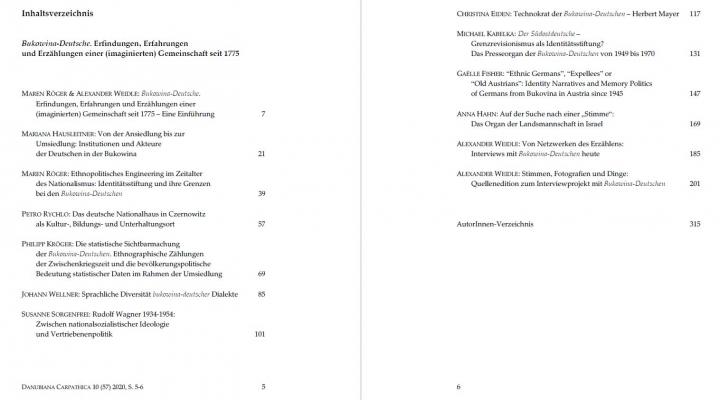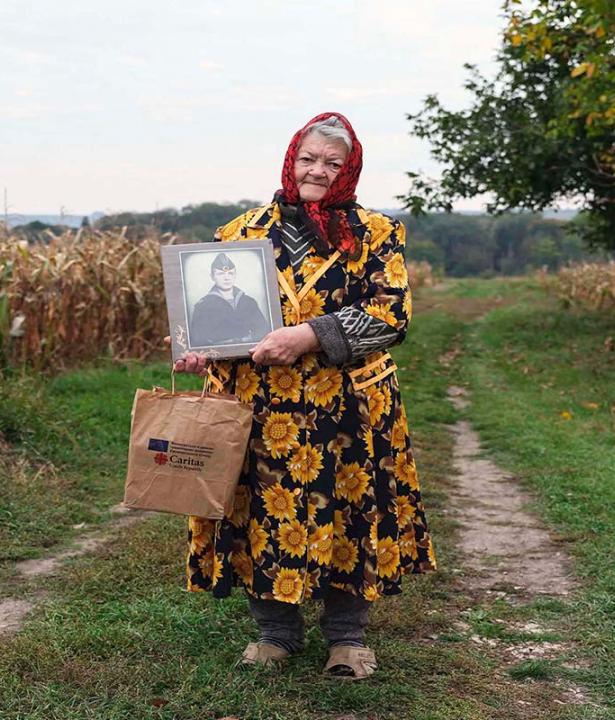The Bukovina Institute at the University of Augsburg has set itself the task of preserving the history of Bukovina and its inhabitants. Inextricably linked to this are narratives of relocation and settlement, of flight and expulsion, and of integration processes in the later Federal Republic, the GDR and Austria.
Text
For a long time, the so-called Bukovina Germans - like other German-speaking settler groups in other parts of East Central and Southeast Europe - did not see themselves as a separate and distinct group. It was not until the interwar period, under the pressure of Romanianization and against the background of general völkisch-nationalist movements, that the unifying character of the German settler groups was more strongly emphasized. The concept of the Bukovina Germans also did not solidify until the end of the 1920s: in the 1910s and 1920s, the formulation of the "Deutschtum[s] in der Bukowina" or "Bukoviner Deutschtum[s]" is found again and again. To be more precise, it can be said that it was only under the further impression of the Nazi ethnic group rhetoric and above all through the experiences of resettlement and loss of homeland that many Bukovina Germans came to develop an enduring sense of identity as a Bukovina German.
This thesis is at the heart of the project Bukovina Germans: Inventions, Experiences, and Narratives of an (imagined) Community. Funded extensively by the Federal Government Commissioner for Culture and the Media (BKM), it comprises two sub-areas:
- First, the publication of a volume in the series "Danubiana Carpathica. Jahrbuch für Geschichte und Kultur in den deutschen Siedlungsgebieten Südosteuropa" (edited by Maren Röger and Alexander Weidle).
- Secondly, an interview project with Bukovina Germans and their descendants (project management by Alexander Weidle).
Publication
Text
When the Habsburg Empire took over Bukovina, it immediately encouraged immigration from German-speaking lands. The immigrants were first (made) Bukovina Germans or Buchenland Germans – through the actions of ethnopolitical entrepreneurs since the 19th century, under the pressure of Romanianization in the interwar period, through offers of the völkisch-deutschnational movement and the consequences of the resettlement in 1940/41. The volume addresses the phases, the extent and the limits of the creation(s) of this group identity.
The thematic volume on Bukovina focuses on the genesis of group identity and includes essays by renowned Bukovina researchers as well as works by young historians. The latter were mainly written within the framework of university qualification work at the Augsburg Junior Professorship for Transnational Interrelations: Germany and Eastern Europe. In their work, the researchers have incorporated numerous previously unprocessed archival materials from the Bukovina Institute's archive, which was newly opened in 2019.


Bukowina-Institut, Free access - no reuse
Bukowina-Institut, Free access - no reuse
Interview project
Text
The intergenerational interview project aims to investigate in several dimensions the question of how the community of the "Bukovina Germans" is founded, experienced and narrated today. Until April 2021, about 140 interviews were conducted in Germany, Austria and Romania, in which interviewees were invited to talk about their life in Bukovina, about resettlement and flight as well as about their later life. In view of the fact that the generation who experienced these events are reaching the end of their lives, this is an incredible and, in many cases, last chance to save these reports for posterity. At the same time, the intergenerational project is also aimed at the descendants and spouses of so-called Bukovina Germans. It seems particularly promising that the interviewees have heterogeneous backgrounds: Their life stories testify to the fact that ethnic affiliation was by no means as clear-cut as it was proclaimed to be in the course of the nationalist-ethnic – and later explicitly racist – movements. At the same time, the narratives form a complex picture of resettlement, settlement and integration processes in the later Federal Republic, the GDR and Austria. In addition to those who (or whose ancestors) were involved in German resettlers' associations or were never represented there, the project also includes French-speaking interlocutors of German and Jewish background or recognized and unrecognized ethnic German immigrants who describe themselves or their families as Romanian rather than German.


Bukowina-Institut, Free access - no reuse
Bukowina-Institut, Free access - no reuse
Practical approach and outlook
Text
The interviews are recorded using a doubly secured system and are based on the three-part procedure common in oral history: A first part, which is not interrupted by queries, allows the interviewees to tell their life story. This procedure aims at allowing for a coherent narration. In the second part, the interviewee is asked questions about their life narrative and the third part is structured using a comprehensive questionnaire or guide.
Finally, in an additional step, photographs or material goods are included. Their description is also recorded; the sources are photographed or scanned. Both sound tracks and photographs will be stored in the Bukovina Institute archive and extensively processed: Thus, memory protocols, keyword indexes and full transcriptions will be created.
After completion of the project, the interviews will be made accessible in an interview archive at the Bukovina Institute, together with other interviews that are available in a comprehensive collection.


Bukowina-Institut, Free access - no reuse
Bukowina-Institut, Free access - no reuse


Bukowina-Institut, Free access - no reuse
Bukowina-Institut, Free access - no reuse
Externe Links
External Image

External Image






